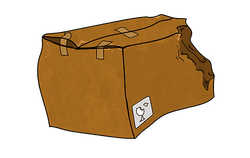Accidents and operational errors, even if undesirable, are part of the routine of logistics activities.
Avoiding them as much as possible is necessary, carriers and logistics operators must adopt measures that reduce those risks.
This way, the activity becomes safer and the costs with material losses are mitigated.
When a product is nonconforming, it is crucial that the software defines the quality state of the product as soon as it arrives to the warehouse (or as soon as possible). Afterwards, the details of the nonconformity must be documented.
The post-analysis may conclude the product is good for consumption (either to be used in production or to be sold to customers) or it has to be destroyed or it has to be returned to the supplier. It is mandatory that all conclusions are well documented and auditable.
Define the different types of quality states
There are several types of quality states:
- damaged
- short batch expiration date
- others

Put the product in quality
When the stock arrives to the warehouse the operator, if necessary, must put the product in quality and define the reason – quality state.

The analysis
Putting the product in quality is not the final process. It is important to have a careful analysis and a consequente action.
The product, most of the times, should be stored on a specific localization of the warehouse until the final analysis is completed – see the details of a quality zone in our previous article.
During that time it is not moved and not even taking into consideration to other processes.
Now I will give you two different possible examples:
- If a product is sent from the supplier already damaged, and the product is considered no longer suitable, the following must take place:
- It is put away to quality and be out of stock
- A claim note must be generated and sent to the supplier
- The product shall be sent to the supplier accompanied by a delivery note
- If a product arrives with a short batch expiration date:
- Is it still saleable for every customer? Then it shall be put away next to the regular stock.
- Is it still saleable but only for certain type os customers? Then it shall be put away in a specific warehouse storage room to be taken into process that takes into consideration only some of the clients.

Conclusion
In conclusion the software should be able to classify all products that enter in the warehouse and have different logistics processes depending on the state of the product.
